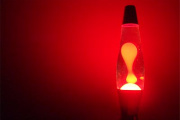The liquid state is a state of matter where molecules move freely. This free movement means that they tend to fill any container they are placed in and mix without restriction. So if liquids are easy mixers, how in the world do you stack them? Let's give it a try.
 Stacking Up the Liquids
Stacking Up the Liquids
Supplies:
- Clear container- preferably a tall, skinny one with a lid
- Dark corn syrup
- Liquid dish washing soap
- Dyed water
- Vegetable oil
- Dyed rubbing alcohol

Procedure:
- Measure your container. Find out how many ounces it can carry. If it doesn’t have it written on the side (most drink bottles will) you can find out by filling the container with water and measuring that water in a measuring cup.
- There are 5 liquids to stack so divide the container by 5 to determine how many ounces of each liquid you will need. For example, if you have a 20 ounce bottle, you will need 4 ounces of each liquid. If it doesn’t divide out perfectly, it’s ok if there’s a little air at the top of your bottle.
- Measure out each liquid. Make sure to add one drop of food coloring to the water and rubbing alcohol. The color is of your choosing, but do pick two different colors.
- Pour each liquid into the container slowly and one at a time in this order: dark corn syrup, liquid dish washing soap, water, vegetable oil, rubbing alcohol.
- And just like legos you’ve stacked liquids!
 Pour The Liquids Slowly
Pour The Liquids Slowly
If you do have a cap for the container then put the cap on tightly and slowly, slowly turn the bottle upside down. The arrangement should hold and the liquids will stack again in the same order.
So how does this happen? One word: density. Density is Mass divided by Volume (D=M/V), which in other words is the amount of “stuff” crammed into an area. It’s very similar to how we think of weight. Something heavier will sink, something lighter will float. Unlike weight though density takes into account the space the object is in. Think of a cake, have you ever heard of someone calling a thick cake dense? Or what about a forest where the trees are tightly packed? That’s a dense forest.
In the case of this experiment, the corn syrup is denser than the rubbing alcohol- it has more molecules packed into it than the rubbing alcohol does so therefore it sinks to the bottom, while the rubbing alcohol floats to the top.
Have Your Say
What other liquids could you add to this experiment? How would these liquids stack up? Share your ideas and hypotheses in the comment’s section below.

































